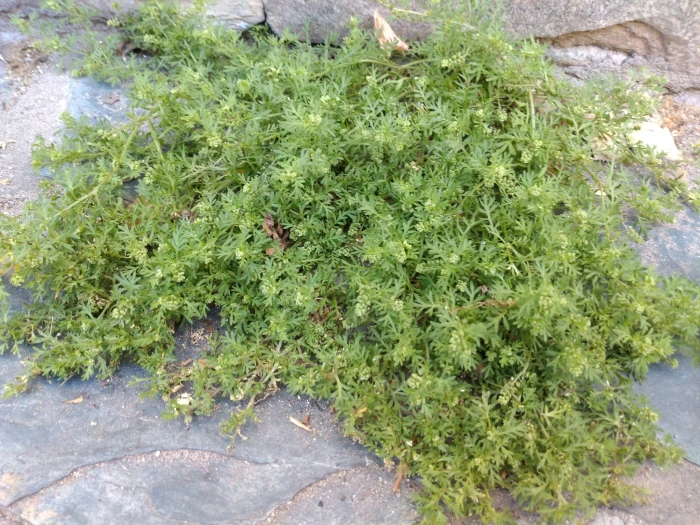Lesser Swine-Cress
(Lepidium didymum)
Lesser Swine-Cress (Lepidium didymum)
/
/

© Cecilia C. Morgan
CC BY-SA 4.0
Image By:
© Cecilia C. Morgan
Recorded By:
Copyright:
CC BY-SA 4.0
Copyright Notice:
Photo by: © Cecilia C. Morgan | License Type: CC BY-SA 4.0 | License URL: http://creativecommons.org/licenses/by-sa/4.0/ | Uploader: calimecita | Publisher: iNaturalist |









































Estimated Native Range
Climate Requirements
| • Precipitation | 0" - 148" |
| • High Temp. | -34°F - 116°F |
| • Low Temp. | -70°F - 70°F |
Summary
Lepidium didymum, commonly known as lesser swine-cress, is an annual or biennial herb that is native to South America but has become naturalized in many other parts of the world, including temperate regions of North America, Europe, and Australasia. It typically grows in disturbed sites, roadsides, and cultivated fields, as well as coastal areas. Lesser swine-cress has decumbent or ascending green stems that can reach up to 16 inches long and bears pinnate leaves. The plant produces clusters of inconspicuous white flowers followed by small, wrinkled fruits. It flowers throughout the year in mild climates.
Lesser swine-cress is not commonly cultivated but may be of interest for its resilience and adaptability to various soil types. It can grow in both full sun and partial shade and tolerates a range of soil conditions, although it prefers moist, well-drained soils. In some regions, it is considered a weed due to its prolific seed production and potential to spread rapidly. Gardeners should be cautious about introducing it to areas where it could become invasive. Its potential invasiveness should be a consideration before planting, and local regulations regarding its cultivation should be consulted.CC BY-SA 4.0
Lesser swine-cress is not commonly cultivated but may be of interest for its resilience and adaptability to various soil types. It can grow in both full sun and partial shade and tolerates a range of soil conditions, although it prefers moist, well-drained soils. In some regions, it is considered a weed due to its prolific seed production and potential to spread rapidly. Gardeners should be cautious about introducing it to areas where it could become invasive. Its potential invasiveness should be a consideration before planting, and local regulations regarding its cultivation should be consulted.CC BY-SA 4.0
Plant Description
- Plant Type: Herb
- Height: 0.5-1.5 feet
- Width: 0.5-1 feet
- Growth Rate: Moderate, Rapid
- Flower Color: White
- Flowering Season: Spring, Summer
- Leaf Retention: Deciduous
Growth Requirements
- Sun: Full Sun
- Water: Medium
- Drainage: Medium, Fast
Common Uses
Edible*Disclaimer: Easyscape's listed plant edibility is for informational use. Always verify the safety and proper identification of any plant before consumption., Low Maintenance
Natural Habitat
Native to South America and naturalized in temperate regions worldwide
Other Names
Common Names: Lesser Pepperwort
Scientific Names: Lepidium didymum, Biscutella apetala, Carara didyma, Cochlearia humifusa, Coronopus didymus, Coronopus didymus f. incisus, Coronopus didymus f. pectinatus, Coronopus didymus subsp. eudidymus, Coronopus didymus var. incisus
GBIF Accepted Name: Lepidium didymum